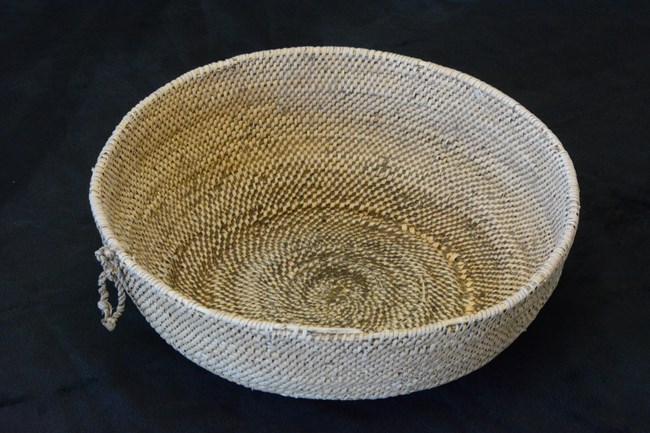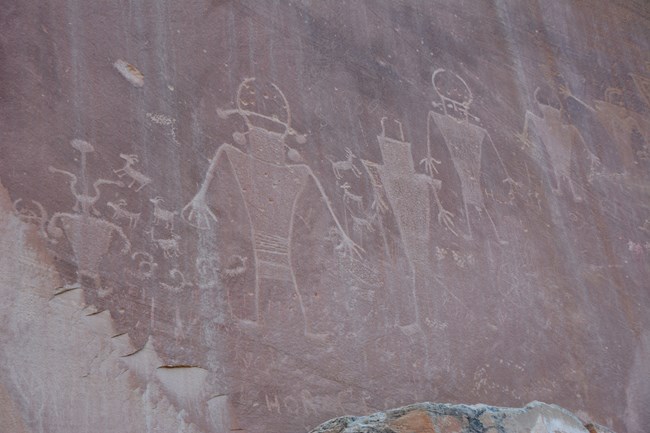|
"…of what value are objects of a past people if we don't allow ourselves to be touched by them. They are alive. They have a voice. They remind us what it means to be human; that it is our nature to survive, to be resourceful, to be attentive to the world we live in." - Terry Tempest Williams from Exploring the Fremont The Fremont CultureFremont and Ancestral Puebloan people began to incorporate farming into their hunter-gatherer lifestyles approximately 2,000 years ago. Petroglyph panels throughout the park depict ancient art and stories of these people who lived in the area from approximately 300-1300 Common Era (CE). Named for the Fremont River that flows through the park, evidence now shows that these people lived throughout Utah and adjacent areas of Idaho, Colorado, and Nevada. The Fremont lived in natural rock shelters and pit houses (dug into the ground and covered with brush roofs). Their social structure was likely composed of small, loosely organized bands consisting of several families. They were closely tied to nature and flexible, making frequent modifications in their life ways as social or environmental changes occurred. 
NPS/ Chris Roundtree Surviving for One Thousand YearsAnthropologists suggest that the Fremont were hunter-gatherers who supplemented their diet by farming corn, beans, and squash along waterways and floodplains. Edible native plants included pinyon nuts, rice grass, and a variety of berries, nuts, bulbs, and tubers. Corn was ground into meal on a stone surface (metate) using a hand-held grinding stone (mano). Deer, bighorn sheep, rabbits, birds, fish, and rodents were hunted using snares, nets, fishhooks, the atlatl (spear-throwing stick) and the bow and arrow. Several artifacts are distinctive to the Fremont. A unique style of basketry, called one-rod-and-bundle, incorporated willow, yucca, milkweed and other native fibers. Pottery, mostly graywares, had smooth, polished surfaces or corrugated designs pinched into the clay. The Fremont made moccasins from the lower-leg hide of large animals, such as deer, bighorn sheep, or bison. Dew claws were left on the soles, possibly providing extra traction on slippery surfaces. 
NPS/Chris Roundtree Signs of a Thriving CulturePictographs (painted on rock surfaces) and petroglyphs (carved or pecked into the rock surface) depict human-like figures, animals, and other shapes and forms. Anthropomorphic (human-like) figures usually have trapezoidal shaped bodies with arms, legs and fingers. The figures are often elaborately decorated with headdresses, ear bobs, necklaces, clothing items and facial expressions. A wide variety of zoomorphic (animal-like) figures exist, including bighorn sheep, deer, dogs, birds, snakes and lizards. Abstract designs, geometric shapes, and handprints are also common. Designs may have recorded religious or mythological events, migrations, hunting trips, resource locations, travel routes, celestial information and other important knowledge. The Fremont moved in small groups, as clans, medicinal societies, or co-residence groups encountering other people and residing with them for periods of time. Gradually these groups merged and dispersed, repeating this process continually in a practice known as residential cycling. This reshuffling continued for thousands of years and coalesced into today's tribal groups. Oral traditions associate the Fremont Culture with the Hopi, Zuni, and Paiute. What is now Capitol Reef is also part of the historic Ute territory. Navajo oral traditions link them to this area as well.
Visit our keyboard shortcuts docs for details
Learn how to protect our shared human heritage and past with rangers at Capitol Reef! |
Last updated: September 20, 2024
